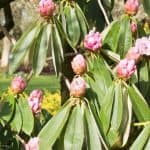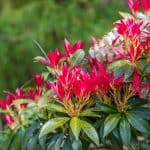Last updated on March 8th, 2022
Our site is reader supported, this means we may earn a small commission from Amazon and other affiliates when you buy through links on our site.
Rhododendrons can be very rewarding plants to have in your garden but it’s important to know how to plant them, how to maintain them, and how to prune them so that you can enjoy them long-term.
It is equally important to know what soil type and position they grow best in because this is something that is essential to Rhododendrons. If planted in the ground they need acidic soil, which is the pH level of 5 or 6, and if grown in containers they need to be planted in ericaceous compost, with John Innes ericaceous loam-based potting compost being the best mix.
Planting Rhododendrons
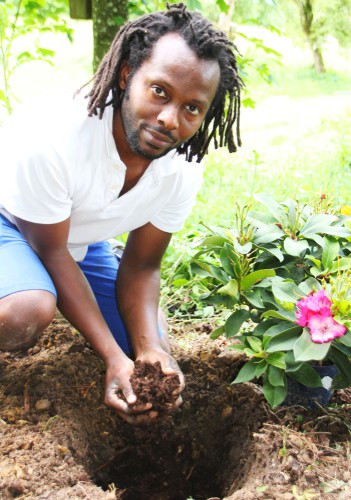
Where to plant
When you decide to plant Rhododendrons you will need to select a site that will be beneficial to the long-term growth and success of your Rhododendrons. This should be a location in your garden that offers dappled shade and is somewhat sheltered from cold winds in winter. You don’t want deep shade and a location underneath other trees may be trial and error because sometimes they do well under trees and sometimes not.
Most of these plants will tolerate open sites as long as they are sheltered from cold winter winds, however, we recommend avoiding planting them where they get the morning sun. If you have a dwarf variety they are likely to be more tolerant of full sun and they grow well in pots, making them perfect for patios and rockeries. The only thing you will need to keep a check on is that the soil doesn’t dry out because they do not like dry soil, this could simply mean more watering over summer.
Type of soil
Rhododendrons require acidic soil that is rich in organic matter so you may need to test the soil ahead of time to make sure it’s somewhere between a pH level of 5 and 6. They also require well-drained soil so make amendments as necessary. Adding some acidic organic matter, such as composted tree bark or conifer clippings into the soil with grit will improve drainage.
If your soil is tested ahead of time and it turns out to have higher levels of alkalinity you will find it very difficult to improve the soil enough to successfully grow Rhododendrons. If this is the case you can try growing your Rhododendrons in a pot that is planted in ericaceous compost.
Choosing the right type of Rhododendron for the right place
If you have a shaded patio that you like to fill with flowering containers, the smaller compact hybrid options are going to be a much better solution because they don’t grow as big but are still larger than the smaller dwarf varieties. If you have a rockery and are looking to add some small shrubs to the mix, the dwarf varieties will be better for you and will also handle full sun better. If you have a woodland garden, look for the larger Rhododendrons because it is their native habitat and they will grow very happily there.
When should you plant Rhododendrons?
When you are ready for planting, October is your first option and this is also when they typically go dormant. Alternatively, you can plant them at the end of March or beginning of April. As Rhododendrons are typically sold in pots, you can also plant them anytime in summer if needed, however, they will require watering frequently. Ideally, you want to be planting in October or March-April.
Preparing the ground with organic matter
You want to add plenty of acidic organic matter to the soil to give them the best possible start, consider items like composted pine needles or tree bark to provide the best possible growing conditions for your Rhododendron. When you do this you want to mix it well into the existing soil. Do not mix in normal compost because this isn’t acidic and if you mix compost into the soil or use it as a mulch, ensure you use ericaceous compost.
Planting
When you plant your Rhododendron remember that it is a surface rooting plant so the roots should be only barely covered. If you plant them too deeply they will not thrive and this is an easy mistake to make. Once you have it planted you should apply a good layer of acidic mulch, such as ericaceous compost or tree bark in a well-aerated fashion. Basically, you don’t want to pack it down but rather help it keep the roots cool.
Growing Rhododendrons in pots
If you are planting Rhododendrons in containers, you want to pick a loam-based potting compost mixture, we found that the John Innes ericaceous potting compost is perfect. It is very important to pay attention to the drainage and to make sure that your plant receives proper drainage and airflow. We recommended that you repot your Rhododendron every few years using fresh potting compost, and this is something you should do at the beginning of spring. In the years in between, you should simply replace the top few inches of compost.
Rhododendron Care
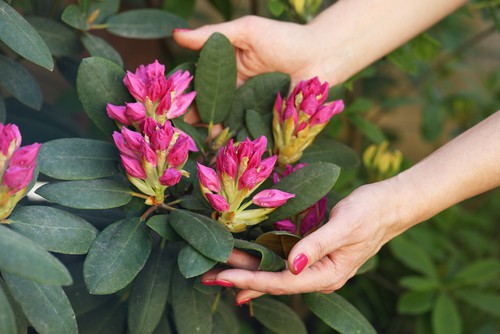
In terms of Rhododendron care, feeding and watering your Rhododendrons is something that should be done on a regular basis. Rhododendrons will thrive in areas that receive high amounts of rainfall so if you live in a dry part of the country it’s important that you water regularly.
Avoid using tap water if you live in a hard water area
Something to note is that if you live in an area with hard water (water companies will be able to tell you if you have hard water) is that you don’t want to use tap water regularly because hard tap water has too much calcium and it reduces the acidity in the soil, subsequently affecting the roots of the plant. We recommend using rainwater as much as possible, for example, that has been collected in a water butt. However, tap water can be used for a few months in the summer if needed, it’s just not recommended for watering all year round.
One of the reasons that people notice yellowing of the leaves on their Rhododendron is because they use tap water which is too hard. If at all possible, collect rainwater throughout the year and use that to water your Rhododendrons. If that runs out you can always go to tap water for a month or two in the hottest parts of the year, something we have previously mentioned.
Feeding
In terms of feeding, you should add ericaceous fertiliser in the spring on an annual basis. This will help to ensure the root structure gets all of the nutrients necessary. Every spring, when your soil is moist you can also renew the mulch around the base of your Rhododendrons.
Pruning Rhododendrons
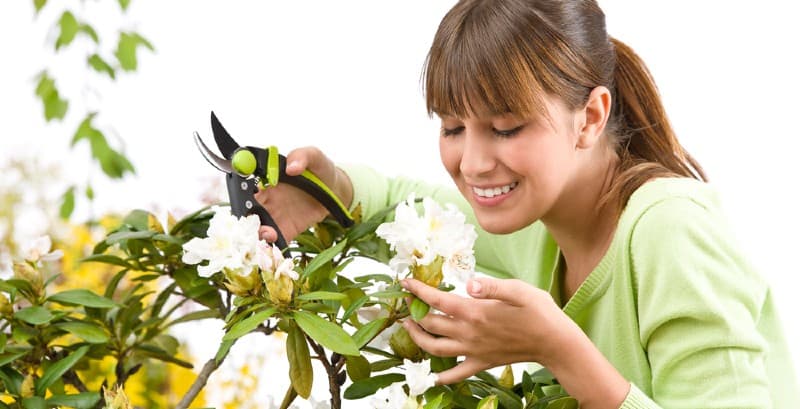
When it comes to pruning, you don’t actually need to do much other than remove the spent flowers (which is known as deadheading) and cut away any dead or diseased wood. You can also prune them to restrict the size, if necessary, but ideally, you want to choose a position that is big enough for the variety you plant.
Either way, if you are deadheading most of the time it’s recommended that you use pruning secateurs or sharp scissors. With this process, you want to sterilise whatever tool you are using. This is particularly true if you are removing dead or diseased branches because a failure to sterilise in between each cut could accidentally transfer things like fungus or bacteria to other parts of the plant or onto other plants.
Hard pruning
If you have an established plant that is out of control or leggy, you can do a hard prune, where you cut back one-third of older stems to the ground and then cut the remaining stems back by around a third. If you need to cut it back any more then we recommend cutting it back over two years. You want to undertake hard pruning between November and March. It will return the following spring with newer growth that is refreshed and ready to bloom.
Potential Problems
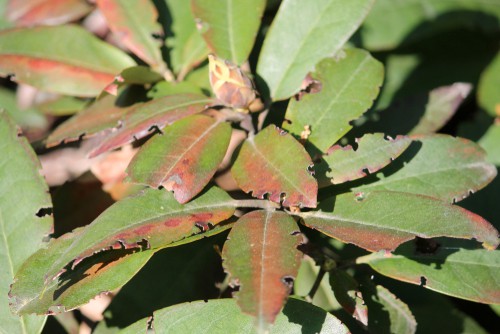
Bud dropping
You need to be aware of different pests and diseases, as well as problems that could take place. Rhododendrons typically produce flower buds at the end of summer, however, if you have a dry spell in your area at the end of summer the flower buds might not form correctly, or they could form partially and then end up dropping off. You can combat this by mulching regularly (as mentioned above) and watering during drier times.
Wilting leaves and leaf drop
Rhododendrons, the same as all evergreen shrubs, will experience a small part of their foliage shedding during the spring and summer, however, leaf drop can also happen if you are experiencing drought in your area, alternatively, if the roots become waterlogged it can also result in leaf drop. Obviously, if you have noticed leaf drop you need to verify whether you’ve experienced a period of drought and if you haven’t, or you don’t see the leaves browning at the edges, you may have problems with drainage, which is something we have previously talked about here.
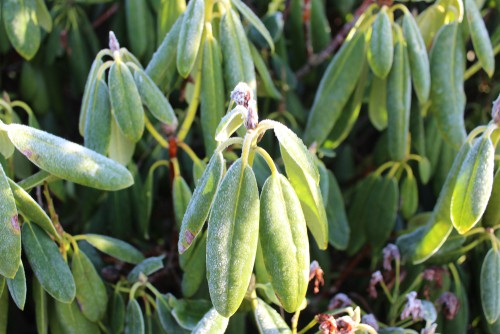
If the leaves are not falling off but they are drooping it could be the result of severe cold weather. If you are experiencing a cold snap and your leaves are drooping then they will return once the conditions improve and the weather warms up a little.
Rhododendrons can be damaged by windy weather and this can result in damage to the flowers, or cause the leaves to become scorched by sunlight, which is why it is recommended that you plant them somewhere they are protected from cold winds.
Pests and Diseases
Vine weevil and scale insects
One insect that you need to be aware of is the vine weevil. This insect is particularly problematic for Rhododendrons grown in containers because not only do the adults eat the leaves, but the baby grubs eat the roots, and when grown in pots this is when it can really become a problem.
Scale insects are also problematic because they suck the sap from the foliage causing damage to the leaves. The problem is that they also excrete honeydew, which is a sticky substance that also encourages black sooty mounds.
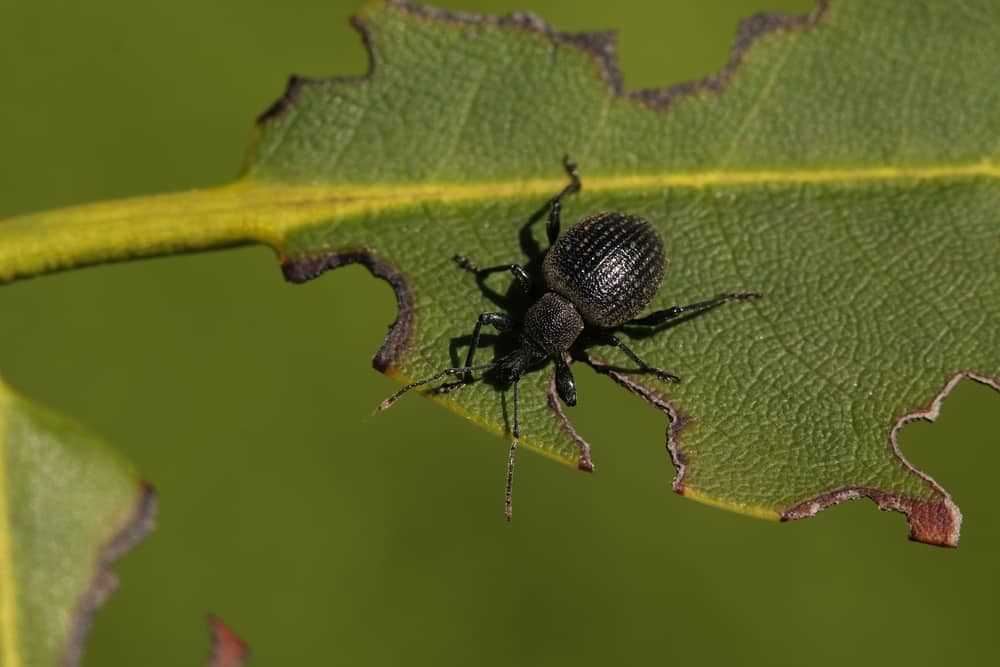
Diseases
Diseases such as Azalea Gall, Bud Blast and honey fungus are amongst the most prominent of issues.
Azealia Gall
Azealia Gall is a type of fungus that won’t kill your Rhododendron but it will disfigure it. It’s an airborne spore that leaves small galls on the leaves that could range in size from that of a pea to a small plum. They start out pale green and turn slightly red, eventually becoming white. You can remove any infected leaves to prevent the spread and if it gets too severe you will, unfortunately, need to replace your plant altogether. This is much more common on the indoor Rhododendrons, the type you usually buy as houseplants.
Honey fungus
Honey fungus is a type of fungus that attacks and kills the roots. It spreads underground and starts to attack the roots of the Rhododendron and then causes dead wood. This is actually one of the most destructive fungal diseases across the UK and no plant is immune. Given that it does attack underground first, you won’t see the dead or decaying roots but you might notice mushrooms or a white fungus material on the bark lower down. Most of the time the above-ground symptoms include smaller leaves, failing a flower, cracking at the bark and death for your plant. Unfortunately, there are no chemical control measures available so you would have to evacuate the damaged plant and burn it or otherwise destroy it.
Propagating
Rhododendrons can be a little difficult to propagate, you can take cuttings from the current season’s growth and we have a detailed guide here. Another way to propagate Rhododendrons is by layering, but this process can take up to 3 years so takes a lot of patience. You can also sow seeds around January in a heated propagator.
Our Favourite Varieties
Rhododendrons come in three main types. The first are evergreen shrubs that are smaller than trees and typically produce flowers all year round. The second are deciduous shrubs and these are much smaller and typically shed their leaves during the autumn and once again in the winter. Evergreen Rhododendrons will grow into the shape of trees and remain green throughout the year.
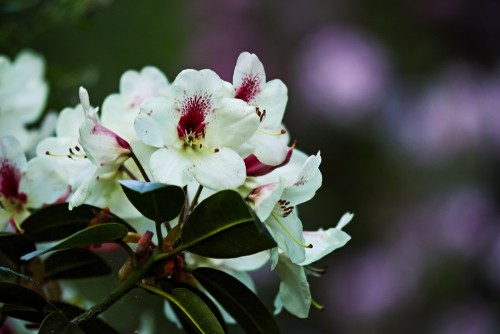
There are over 1,000 species that fall into these three main categories but one of our favourites includes the Rhododendron ‘Elviira’. This is a broadleaf, evergreen shrub that produces cherry-red flowers. The flowers are shaped like a trumpet and they have a beautiful scent to them that isn’t too overpowering. This one is low maintenance as far as shrubs go, and all you really need to do is deadhead.
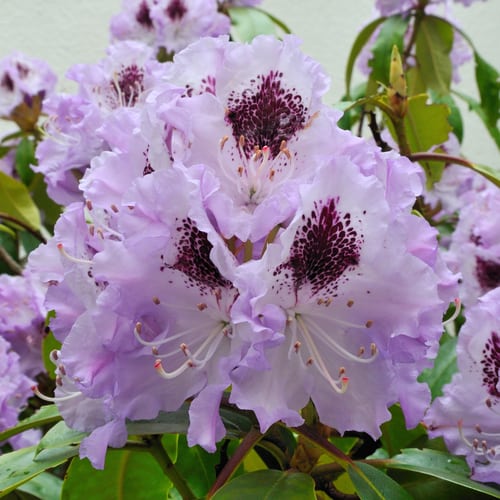
Another favoured variety is the Rhododendron ‘Blue Peter’, which is pictured above. This is an evergreen shrub and it has a colourful, dense head on the leaves with violet-blue flowers that come in funnel-shaped, tubular shapes or bell shapes. They also offer frilled petals that are unique and simply stunning. This is a bushy shrub that will reach up to 3 metres in height. It is ideally suited to be a hedge, privacy screen or specimen plant.
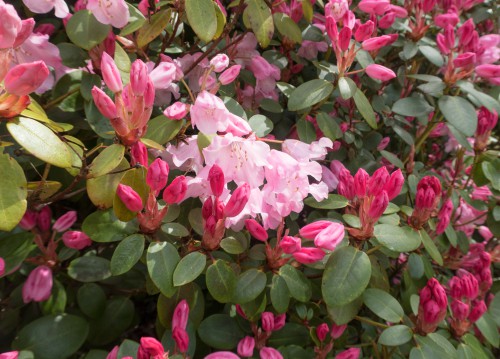
The Rhododendron ‘Bow Bells’ (which is pictured above) is another favourite. It is an evergreen shrub that will grow in a vertical fashion and reach approximately 1m in the span of 10 years, giving it a much slower growth rate compared to others. The flowers are shaped like a bell and they grow in loose clusters taking on bright pink shades.
The Rhododendron ‘Windsong’ stands out with its yellow, funnel-shaped flowers that include red nectarines in the centre. These flowers take on a bell shape and can actually hold 14 flowers in a single truss.
The Rhododendron ‘White Angel’, as the name suggests, forms stunning white flowers that grow out of a vase-shaped cone and are very long. Each flower reaches about 3cm in diameter and you can enjoy clusters of flowers throughout the spring. Maintenance is very little, all you need to do is deadhead here and there, and then watch as the shrub takes on its round shape.

